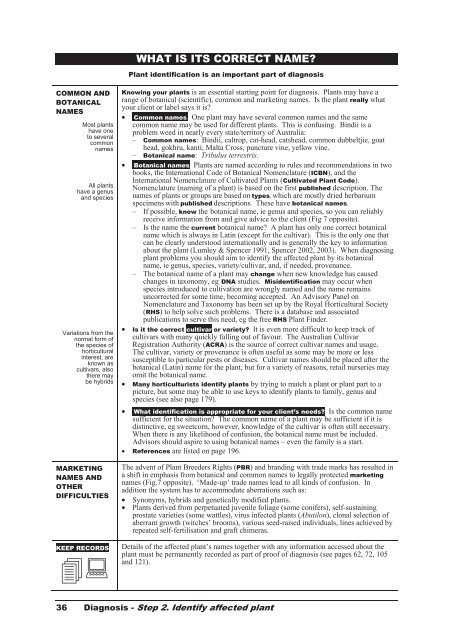PLANT PROTECTION 4
PLANT PROTECTION 4
PLANT PROTECTION 4
You also want an ePaper? Increase the reach of your titles
YUMPU automatically turns print PDFs into web optimized ePapers that Google loves.
COMMON AND<br />
BOTANICAL<br />
NAMES<br />
Most plants<br />
have one<br />
to several<br />
common<br />
names<br />
All plants<br />
have a genus<br />
and species<br />
Variations from the<br />
normal form of<br />
the species of<br />
horticultural<br />
interest, are<br />
known as<br />
cultivars, also<br />
there may<br />
be hybrids<br />
MARKETING<br />
NAMES AND<br />
OTHER<br />
DIFFICULTIES<br />
KEEP RECORDS<br />
<br />
WHAT IS ITS CORRECT NAME?<br />
Plant identification is an important part of diagnosis<br />
Knowing your plants is an essential starting point for diagnosis. Plants may have a<br />
range of botanical (scientific), common and marketing names. Is the plant really what<br />
your client or label says it is?<br />
Common names. One plant may have several common names and the same<br />
common name may be used for different plants. This is confusing. Bindii is a<br />
problem weed in nearly every state/territory of Australia:<br />
– Common names: Bindii, caltrop, cat-head, catshead, common dubbeltjie, goat<br />
head, gokhru, kanti, Malta Cross, puncture vine, yellow vine.<br />
– Botanical name: Tribulus terrestris.<br />
Botanical names. Plants are named according to rules and recommendations in two<br />
books, the International Code of Botanical Nomenclature (ICBN), and the<br />
International Nomenclature of Cultivated Plants (Cultivated Plant Code).<br />
Nomenclature (naming of a plant) is based on the first published description. The<br />
names of plants or groups are based on types, which are mostly dried herbarium<br />
specimens with published descriptions. These have botanical names.<br />
– If possible, know the botanical name, ie genus and species, so you can reliably<br />
receive information from and give advice to the client (Fig 7 opposite).<br />
– Is the name the current botanical name? A plant has only one correct botanical<br />
name which is always in Latin (except for the cultivar). This is the only one that<br />
can be clearly understood internationally and is generally the key to information<br />
about the plant (Lumley & Spencer 1991, Spencer 2002, 2003). When diagnosing<br />
plant problems you should aim to identify the affected plant by its botanical<br />
name, ie genus, species, variety/cultivar, and, if needed, provenance.<br />
– The botanical name of a plant may change when new knowledge has caused<br />
changes in taxonomy, eg DNA studies. Misidentification may occur when<br />
species introduced to cultivation are wrongly named and the name remains<br />
uncorrected for some time, becoming accepted. An Advisory Panel on<br />
Nomenclature and Taxonomy has been set up by the Royal Horticultural Society<br />
(RHS) to help solve such problems. There is a database and associated<br />
publications to serve this need, eg the free RHS Plant Finder.<br />
Is it the correct cultivar or variety? It is even more difficult to keep track of<br />
cultivars with many quickly falling out of favour. The Australian Cultivar<br />
Registration Authority (ACRA) is the source of correct cultivar names and usage.<br />
The cultivar, variety or provenance is often useful as some may be more or less<br />
susceptible to particular pests or diseases. Cultivar names should be placed after the<br />
botanical (Latin) name for the plant, but for a variety of reasons, retail nurseries may<br />
omit the botanical name.<br />
Many horticulturists identify plants by trying to match a plant or plant part to a<br />
picture, but some may be able to use keys to identify plants to family, genus and<br />
species (see also page 179).<br />
What identification is appropriate for your client’s needs? Is the common name<br />
sufficient for the situation? The common name of a plant may be sufficient if it is<br />
distinctive, eg sweetcorn, however, knowledge of the cultivar is often still necessary.<br />
When there is any likelihood of confusion, the botanical name must be included.<br />
Advisors should aspire to using botanical names – even the family is a start.<br />
References are listed on page 196.<br />
The advent of Plant Breeders Rights (PBR) and branding with trade marks has resulted in<br />
a shift in emphasis from botanical and common names to legally protected marketing<br />
names (Fig.7 opposite). ‘Made-up’ trade names lead to all kinds of confusion. In<br />
addition the system has to accommodate aberrations such as:<br />
Synonyms, hybrids and genetically modified plants.<br />
Plants derived from perpetuated juvenile foliage (some conifers), self-sustaining<br />
prostate varieties (some wattles), virus infected plants (Abutilon), clonal selection of<br />
aberrant growth (witches’ brooms), various seed-raised individuals, lines achieved by<br />
repeated self-fertilisation and graft chimeras.<br />
Details of the affected plant’s names together with any information accessed about the<br />
plant must be permanently recorded as part of proof of diagnosis (see pages 62, 72, 105<br />
and 121).<br />
36 Diagnosis - Step 2. Identify affected plant







![[Compatibility Mode].pdf](https://img.yumpu.com/27318716/1/190x135/compatibility-modepdf.jpg?quality=85)









